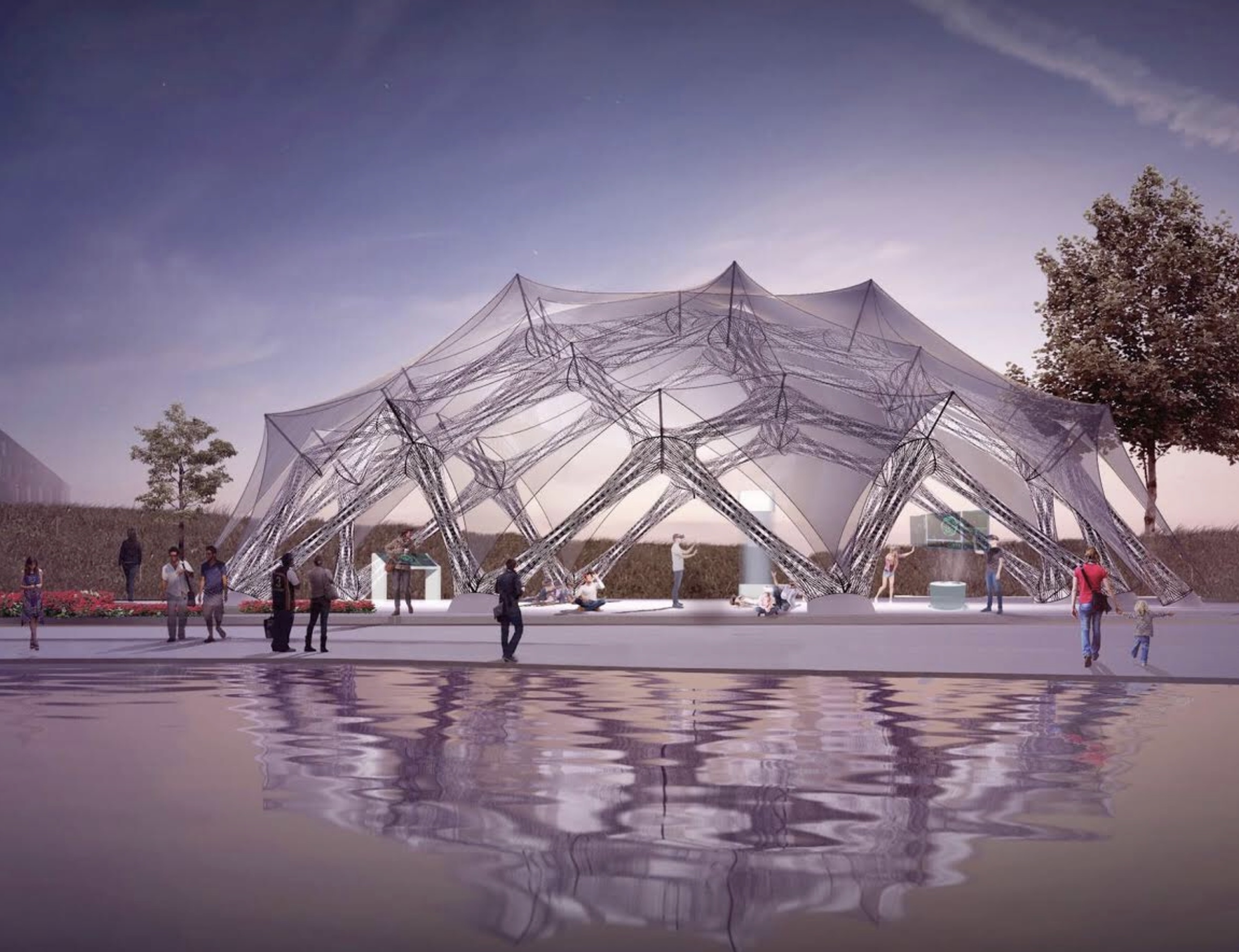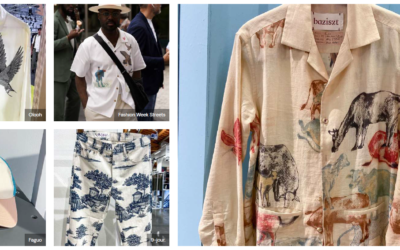What is Architecture Fabric?
Architecture fabric, in one sentence, is the fabric used in architecture by manipulating the different properties of textile fibers to make fabric suitable of manifesting architectural designs into reality.
Each textile fiber has its own set of characteristics. As a result, different fibers can be used on different grounds according to requirements and made into architecture fabric-the new use of textile as a building material, which is more suitable, durable and sustainable than concrete or other conventional materials.
High-performance fibers are synthetic fibers in which high added value textile properties like high tensile strength, high modulus, greater elongation, higher operating temperature, higher chemical resistance, higher durability etc. are found. These are mostly used as architectural fabric.
Why Architecture Fabric is Used?
Textile fibers are used in architecture for being light in weight, for higher tensile strength, higher elongation, resiliency, thermal insulation etc. By combining the need of the construction sector and the properties of textile fiber, architecture fabric or architectural fabric (a technical textile) has opened a new horizon between these two sectors.
Architecture fabrics are now used for building safety, earthquake resistance, UV protection, noise prevention, tear resistance, bacteria resistance, insulation, visual protection, water vapor impermeability, air conditioning and protection from rain, sun, wind, fire.
Textile as Architectural Membrane
Textile is considered as the 5th material which is used in architecture like timber, stone, metal and glass. The tent is the oldest version of using textile in architecture which is used for separating an environment or space from nature. The tent is the oldest version of the dwelling also. The Nomad used it as a covering of their living place. They carried tents for the convenience of moving them from one place to another.

Tent, the the oldest version of using architecture fabric, more accurately ‘architectural fabric’. Courtesy: Pexels.com
From when human started to settle down in a specific place, the use of textile to make dwellings started to be neglected. But now, textiles are also used as membranes for various architectures.
Elie Tahari Fashion Showroom is the creation of an architect named Gisela Stromeyer. To make this, she has used fabric instead of the concrete wall to enhance the space.
Elie Tahari Fashion Showroom, created by Gisela Stromeyer. To make this, she has used architecture fabric instead of the concrete wall to enhance the space. Courtesy: Architonic, Photographer: © Michael Moran
This aesthetic design also allows natural light to enter the room and reduces artificial lighting costs. This transportable membrane can be folded when it’s not needed.
DAR LUZ is also an example of the temporary installation of textile fabric in which fabrics are stretched over a wooden structure.
Tubaloon is a textile sculpture. The membrane of this sculpture is made from a special PVDF (Polyvinylidene Fluoride) fabric coated with PVC (polyvinyl chloride) which is weather-resistant and also diffuses light onto the surface.
Translucent PTFE coated glass fiber is used in the tall atrium of Burj Al Arab Hotel of Dubai which can withstand large-scale temperature variation, sandstorms and fire.
This membrane is highly UV resistant, non-combustible and also allows natural daylight with sufficient shading. It has also the property of self-cleaning after raining.
Burj Al Arab Hotel, Dubai. Courtesy: Pexels.com
Fabric Structure in Architecture
The history of using fabric structure in architecture is too old. The first initiative of developing architectural fabric structures came from the advantage of using the sail.
In the first century BCE, Roman used “Textile sunshade roof system” in theatres, circuses, amphitheaters and stadiums. And that was made by reusing the old naval sail. That step opened a new door for the use of fabric structures in architecture.
Now, the use of fabric structure is increasing for lightweight, cost-effectiveness, easy portability, easy reconfiguration, lower energy consumption, durability, environment sustainability, ventilation, less construction period and so on.
Tensioned fabric structures are divided into three groups named (a) Boundary Tensioned Membrane (b) Pneumatic or Air supported Structure (c) Cable-net. Anticlastic and Synclastic are two structural forms that are used to stabilize fabric structures in architecture.
To stabilize a membrane anticlastic structure is more effective. The synclastic structure is sometimes also referred to as an air-supported structure that is used as the roof of tennis courts, swimming pools or fields to control weather conditions.
The famous architecture fabric roof of Denver International Airport is an example of an anticlastic structure and it is made of double-layer PTFE-coated fiberglass membrane. This roof allows light to pass through the fabric and reflect 90 percent solar radiation.
The famous architecture fabric roof of Denver International Airport. Source: Wikimedia.
;Earlier, cotton was used as a material of fabric structure element.
In modern days, coated and laminated fabrics are used as fabric structures to increase strength, durability and various properties.
Polyester, nylon, aramid, fiberglass are most commonly used as structural fabric.
PVC, PTFE and Silicone are the most common coatings of structural fabrics.
People who are Working with Architectural Fabric
Gisela Stromeyer, a famous artist and architect, whose aesthetic and creative works with architectural fabrics are getting admired worldwide.
Gisela Stromeyer. Source: Architonic.com
Instead of the concrete wall, she has used architectural fabrics to increase space.
The ancestors of Gisela Stromeyer were tentmakers. Peter Stromeyer, the father of Gisela Stromeyer, worked with Frei Otto.
Frei Otto is considered the founder of the fabric tension structure industry. Frei Otto focused on lightweight structures. One of his paper publications, based on lightweight structures, inspired an architect named Hans Spettbacher to use a double layer of cotton fabric in the design of the Swiss Pavilion.
Later on, the combined work of Peter Stromeyer and Frei Otto played a vital role in the upcoming field of the tensile fabric structure. The use of tensile fabric structures got started.
Frei Otto is considered the founder of the fabric tension structure industry. One of the founding of architecture fabric. courtesy: flickr.com
Munich Olympic Stadium, Multihalle in Mannheim, The Tuwaiq Palace, The German Pavilion are some of his renowned projects in which he used fabric for lightweight structure.
Kengo Kuma is a Japanese architect who has used architectural fabrics for sustainable architecture. ‘We Hotel Toya’ and ‘House in Hokkaido’ are two of his famous creations.
Munich Olympic Stadium Courtesy: Wikimedia.org
Textile as a Construction Material
Nowadays, textiles are not only used as temporary elements but also permanent elements of architecture.
Build tech is the sector in which textiles are used in construction.
When textile materials are used with concrete, various properties such as protection against UV and electromagnetic radiation, earthquake resistance, fire retardant, antibacterial property get increased.
Textile Re-enforced Concrete (TRC) is now being used as construction material to a great extent for various advantages.
The textile fibers used for TRC are glass-fiber, jute, kevlar, nylon, polyamide etc.
TRC gives higher strength compared to its weight than steel. Its durability is also greater than steel.
TRC is more corrosion resistant. It can also be used as a protective layer of old constructions. Moreover, fiber-reinforced cement or concrete are highly used in structural application which can bear electro-mechanical deterioration. It can also prevent the effect of alkali, acid and salt.
Textile in Earthquake Resistance
Earthquake resistant technology indicates that the building or structure should be made in such a way that the horizontal movements of quakes be absorbed before they reach to the building.
Moreover, to be earthquake resistant, material has to be bent out of the shape without making any failure.
Steel and concrete have to bear large seismic force as this force is proportional to the mass of the structure. Steel and concrete which are usually used in construction cannot withstand this strong seismic force.
If lightweight textile materials are used there, the seismic force will be less also.
Newly invented PVC-ECC (Polyvinyl alcohol fiber-reinforced engineered cementitious composite) has high tensile strain capacity and ductility which can absorb energy from earthquakes & resist seismic force to save buildings.
Fiber-reinforced cement (FRC) is made of high-strength fiber set in a resin matrix.
The use of high-strength fiber & elastomeric polymer in the wall can make the wall stronger against seismic load.
Lightweight & high-strength aramid fibers are used in wall construction to prevent walls from breaking during rebound.
A jacket made from glass fiber and isophthalic polyester resin is now used to reduce the risk of seismic force.
The column is surrounded by the jacket. The jacket prevents concrete to expand due to a rise in temperature or seismic forces.
Thus jackets made from high-performance fiber-glass are used to get protection from the earthquake.
For repairing concrete bridge, carbon FRC is more desirable than steel for its lightweight. Concretes are wrapped with carbon fiber to prevent tensile crake.
Compressive strength is also higher in a wrapped one. For wrapping, steel is not a solution for the issue of environmental attack.
Carbon FRC has no environmental attack issue. So it is preferred in this sector.
Wrap of one layer increases the strain 6 times which has great importance for resisting earthquakes. But in this case, glass fibers are more preferred for having low stiffness and for not costly as carbon.
A three-storied building in Japan has been covered by carbon string. These carbon strings are made of thermoplastic carbon fiber composite. The lighter carbon string rods are seven times stronger than iron.
As a result, during earthquakes buildings don’t fall down, just sway together. This structure looks like spider webs in which rods are tied to the roof and gripped on the ground.
Nano-textile is also used in the construction industry to make concrete lighter, stronger, resistant to earthquakes. Seismic wall paper is used to increase resistance to crack and collapse.
Seismic wallpaper is made based on reinforced textile composite which incorporates several elements such as multiaxial warp knitted glass, polymer fiber and nano-particle enhance coat.
Insulation and Textile
Textiles materials or recycled textiles are considered as the best insulating material as it’s not as harmful to health as stone wool, glass wool etc.
The porous structure of non-woven textiles has made textile material as a perfect element of thermal and sound insulation.
Sheep wool is a highly insulative material. It is used in the wall which gives the indoor a cozy atmosphere. But for being expensive, wool and cotton are not used normally. Moreover, waste from textile fiber has played a vital role to use as an insulator.
Thermobond is an insulation product which is developed by Scottish Research and Design Studio. Wool and polyester is the element of this Thermobond. It has higher thermal conductivity.
A French recycling company has also made a thermal insulation product called ‘Mettise’ which is used for insulating of ceiling roofs and walls. Recycled fiber, cotton, wool, polyester are used as a binder in this product.
Mermet is a solar protection fabric that can maintain thermal insulation in a house.
Textile as Acoustic Material
Acoustic materials can absorb sound to make the environment noise-free or soundproof. The energy of sound from the environment is absorbed by the porous structure of elements used in-wall or any construction. And in this section, non-woven textile works properly for their porous structure.
For good sound absorption properties of fiberglass and non-woven fabrics, these are used for soundproofing of the wall.
To make a soundproof wall, three or more than three layers are used. The second layer made of fiberglass and non-woven fabric is used to sound absorption and this layer is cover by the first one.
The last layer is fixed with the wall and it is made of plywood or timber frame.
When sound waves strike on an acoustic layer, the particle of acoustic material start to vibrate and create heat energy. The absorbed sound energy is come out as heat energy.
The using of textile in architecture is increasing day by day. The manufacturing process of textile materials is easy and more time-saving than any other construction materials. Almost 11% of technical textiles are used in the build tech sector. As much innovation can be brought in the technical textile sector, the use of textile in architecture will be increased continuously.
Sumita Bhattacharja Joly
Bangladesh University of Textiles
44th Batch.
Reference:
- An article: The Very Fabric of Architecture: textile use in construction. By Susanne Fritz.
- https://www.bdcnetwork.com/carbon-fiber-strings-make-japanese-office-building-earthquake-resistant
- https://www.slideshare.net/wasimchavhan/acoustic-textiles-sound-absorbing-textile
- https://civilengineeringnotes.com/acoustic-material-types/
- https://www.architonic.com/en/microsite/gisela-stromeyer-design/5205374
- https://en.m.wikipedia.org/wiki/Frei_Otto
- https://www.designingbuildings.co.uk/wiki/The_history_of_fabric_structures
- https://www.designingbuildings.co.uk/wiki/Anticlastic_structures
- https://fabricarchitecturemag.com/2012/07/01/zusammenarbeit-collaboration-of-frei-otto-and-peter-stromeyer/
- https://fabricarchitecturemag.com/2008/07/01/pioneering-the-field-the-founding-father-of-the-fabric-tension-structure-industry/
- https://www.google.com/search?q=textile+in+architecture+graduation+report&client=firefox-b-d&channel=trow5&sxsrf=AOaemvL2ZGgXxkWOzpqRa1VDLDJKwq-pmA%3A1631989911006&ei=ljBGYejzPLPjz7sP9uKv0Ao&oq=&gs_lcp=Cgdnd3Mtd2l6EAEYAjIHCCMQ6gIQJzIHCCMQ6gIQJzIHCCMQ6gIQJzIHCCMQ6gIQJzIHCCMQ6gIQJzIHCCMQ6gIQJzIHCCMQ6gIQJzIHCCMQ6gIQJzIHCCMQ6gIQJzIHCCMQ6gIQJzoHCCMQsAMQJzoECCMQJ0oECEEYAVC0OljZRGCWY2gCcAB4BIABqAiIAfchkgEJMy0xLjYtMi4ymAEAoAEBsAEKyAEBwAEB&sclient=gws-wiz
- https://www.architectural-review.com/today/house-in-hokkaido-japan-by-kengo-kuma
- https://www.architonic.com/en/story/peter-smisek-pure-fabrication-textiles-in-architecture/20087873
- https://www.researchgate.net/publication/296350016_Textile_in_House_Building_Civil_Applications
- https://www.researchgate.net/publication/266601387_GLASS_FABRIC_COMBINATION_FOR_ACOUSTICES_OF_BUILDING_INTERIOR
- https://www.researchgate.net/publication/269548685_Textiles_in_Earth-Quake_Resistant_Constructions
- https://www.researchgate.net/publication/349764819_Sustainable_Textile_Architecture_History_and_Prospects
- https://www.slideshare.net/esnygn/technical-textiles-for-buildtech
- https://www.researchgate.net/publication/334758325_Textile_as_a_sustainable_insulating_material_for_buildings
Now as you have read about ‘Architecture fabric’, you can also read our another special article ‘Invisible cloak technology’!
You can also read our well researched article on Fast fashion vs slow fashion here!
You can also read this premium article on the 21st century fashion!





0 Comments
Trackbacks/Pingbacks